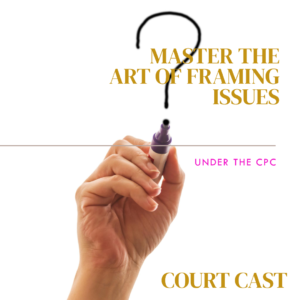I. Introduction
Framing issues is a fundamental step in the process of litigation. Properly framed issues not only guide the course of the trial but also determine the admissibility of evidence and the ultimate outcome of the case. The Code of Civil Procedure (CPC) in many jurisdictions provides a framework for framing issues. This comprehensive practice note aims to provide a thorough understanding of the art of framing issues under the CPC.

II. Significance of Framing Issues
The framing of issues under the CPC serves several important purposes:
- Focus on Relevant Matters: Framing issues helps narrow down the points of contention and ensures that only relevant matters are considered during the trial.
- Admissibility of Evidence: Properly framed issues dictate what evidence can be admitted during the trial. Evidence must be relevant to the issues framed.
- Efficient Trial Management: Framed issues streamline the trial process, making it more efficient and saving time and resources.
- Clarity for Parties: Parties involved in the litigation have a clear understanding of the specific matters in dispute, allowing them to prepare their cases accordingly.
III. Legal Provisions
Framing of issues is primarily governed by the CPC. The relevant provisions may vary from one jurisdiction to another. It is essential to refer to the specific provisions applicable in your jurisdiction. Below is a general overview:
| Jurisdiction | Relevant CPC Provisions |
|---|---|
| India | Order XIV, Rule 1-4 |
| United States | Federal Rules of Civil Procedure (FRCP) Rule 16(c) |
| United Kingdom | Civil Procedure Rules (CPR) Part 16 |
IV. Steps for Framing Issues
To master the art of framing issues, follow these steps:
- Review the Pleadings: Begin by thoroughly reviewing the pleadings of the parties, including the plaint, written statement, and any subsequent pleadings. Identify the key facts and legal contentions raised by each party.
- Identify Material Facts: Distinguish between material facts (those directly relevant to the case) and immaterial facts (those not directly related to the dispute). Material facts form the basis for framing issues.
- Formulate Clear and Concise Issues: Frame the issues in a clear, concise, and unambiguous manner. Each issue should be framed as a question that the court needs to answer to resolve the dispute.Example:
- Instead of “Whether the defendant was negligent?” frame it as “Whether the defendant breached the duty of care owed to the plaintiff?”
- Instead of “Whether the plaintiff suffered damages?” frame it as “Whether the plaintiff incurred financial losses as a direct result of the defendant’s actions?”
- Avoid Compound Issues: Each issue should pertain to a single point of contention. Avoid framing compound issues that combine multiple legal questions.Example of a compound issue:
- “Whether the defendant breached the duty of care and caused damage to the plaintiff?”
- Ensure Legal Relevance: Verify that the framed issues are legally relevant and address the essential elements of the claims and defenses presented by the parties.
- Balance the Issues: Ensure that the framed issues are balanced and do not unfairly favor any party. Both parties should have an equal opportunity to present their case.
V. Sample Framed Issues
To illustrate the process, here are sample framed issues for different types of cases:
Civil Tort Case:
| Issue No. | Issue |
|---|---|
| Issue 1 | Whether the defendant’s negligence caused the accident and injuries suffered by the plaintiff? |
| Issue 2 | Whether the plaintiff’s actions contributed to the accident and, if so, to what extent? |
Contract Dispute:
| Issue No. | Issue |
|---|---|
| Issue 1 | Whether the contract between the parties is valid and enforceable? |
| Issue 2 | Whether the plaintiff performed their obligations under the contract as required? |
| Issue 3 | Whether the defendant breached the contract and, if so, what damages are recoverable? |
Family Law Case:
| Issue No. | Issue |
|---|---|
| Issue 1 | Whether there are grounds for divorce as claimed by the petitioner? |
| Issue 2 | Whether the custody of the children should be awarded to one or both parents, and what visitation rights should be granted? |
| Issue 3 | Whether there should be a division of marital property, and if so, how should it be divided? |
VI. Role of the Court
In many jurisdictions, it is the responsibility of the court to frame the issues. However, the court often relies on the submissions of the parties to determine the issues to be framed. As an advocate, it is essential to effectively present your case to influence the framing of issues in your favor.
VII. Amending Framed Issues
The CPC typically allows for the amendment of framed issues if necessary. This can be done by filing an application before the court, explaining the reasons for the proposed amendment. The court will consider whether the amendment is just and in the interest of justice.
VIII. Conclusion
Mastering the art of framing issues under the CPC is a crucial skill for any litigator. Properly framed issues set the stage for a fair and efficient trial. By following the steps outlined in this practice note and ensuring that issues are clear, concise, and legally relevant, you can enhance your ability to advocate effectively and achieve favorable outcomes for your clients. Remember to always consult the specific provisions of t


